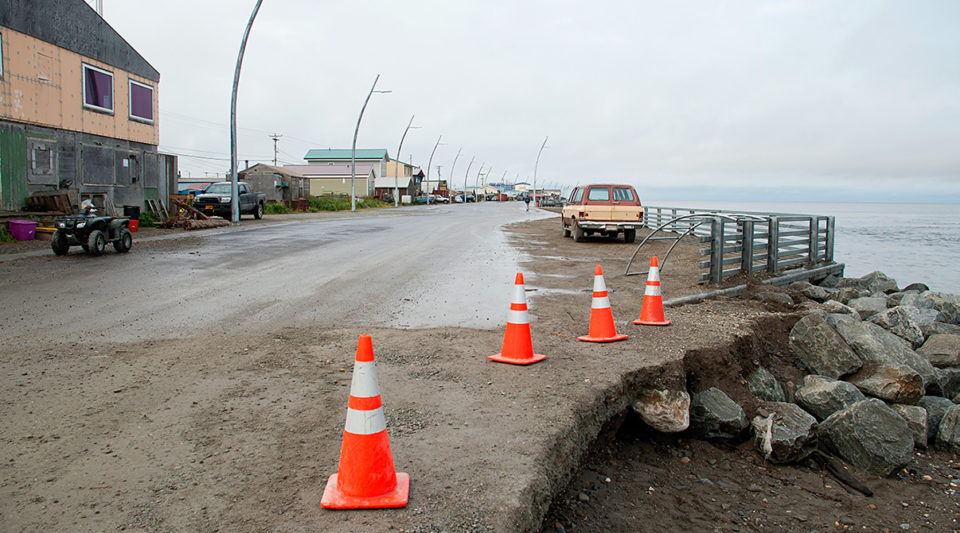Alaska’s tidal coastline spans over 46,600 miles, more than that of the lower 48 states combined. Portions of Alaska’s coast are among the nation’s most vulnerable to geohazards from climate change, extra-tropical storm surge, wind waves, tsunamis, ice and erosion. Because of this there is a critical need to improve water-level forecasting tools and the density of the water-level measurement network statewide.
A team of researchers at the University of Notre Dame is developing an integrated wave-surge-ice forecast model to more accurately predict coastal water levels, currents, waves, ice and related flood hazards on Alaska’s coastal floodplains. The team’s work will help Alaskan communities assess threats from a specific storm and determine the potential impact of a flood and evaluate safe evacuation routes.
“The Alaskan coast, an irreplaceable natural and economic resource, encompasses an extensive continental shelf and coastal floodplains,” said Joannes J. Westerink, the Joseph and Nona Ahearn Professor of Computational Science and Henry J. Massman Chair of the Department of Civil and Environmental Engineering and Earth Sciences at Notre Dame. “Strong winter storms, changing sea ice cover, wind waves and the intricacies of air-sea momentum transfer make predicting water levels and flood-related hazards a challenge.”
Alaska’s changing environment, highlighted by sustained warmth, less and more fragmented sea ice and late ice formation and early ice break-up, is also causing problems, Westerink said. For example, sea ice modulates regional storm surge response and can either mitigate storm surge or greatly enhance it. Sea ice can also effectively damp out wind waves. Correctly simulating this complex physics is particularly critical during winter months when the arctic sees its largest and most intense storms.
Westerink and his team will integrate information on surge and tides; wind waves; and ocean temperatures, salinities, and currents; along with sea ice properties by coupling several existing models. Together these models can better account for the combined processes of the ocean around Alaska, producing more accurate forecasts as part of the integrated Alaska Coastal Ocean Forecast System.
“The linkages and interactions between the four existing models will help us better visualize the impact of storm events,” said Westerink. “Each model focuses on a specific process in the environment and will inform the other models, so we’ll be able to span the entire energy spectrum of the ocean. The combined model physics, together with the implementation of high-resolution unstructured computational meshes in the nearshore and coastal floodplains, will produce highly localized results, giving communities a better picture of an event and helping ensure their safety.”
Westerink, will serve as the principal investigator on this project. Other researchers at Notre Dame who will contribute to the project include Damrongsak Wirasaet, research assistant professor; David Richter, associate professor; Guoming Ling, doctoral research associate; and Mindo Choi, research fellow.
The team also includes researchers from the University of Texas at Austin; The National Oceanic and Atmospheric Administration’s (NOAA) Great Lakes Environmental Research Laboratory; Cooperative Institute for Great Lakes Research at the University of Michigan; Alaska Ocean Observing System; Axiom Data Science; NOAA’s National Center for Environmental Prediction; and NOAA’s National Ocean Service — Coast Survey and Development Laboratory.
Project collaborators include the Alaskan Division of Geological & Geophysical Surveys and Alaska’s National Weather Service and Weather Forecast Offices. Partners include the Alaska Division of Geological and Geophysical Surveys, Western Alaska Land Conservation Cooperative, and Alaska’s NOAA National Weather Service Weather Forecast offices. The project is funded by an Integrated Ocean Observing System, Ocean Technology Transition Project Grant.
Westerink is an affiliated member of Notre Dame’s Environmental Change Initiative.
— Nina Welding, College of Engineering
